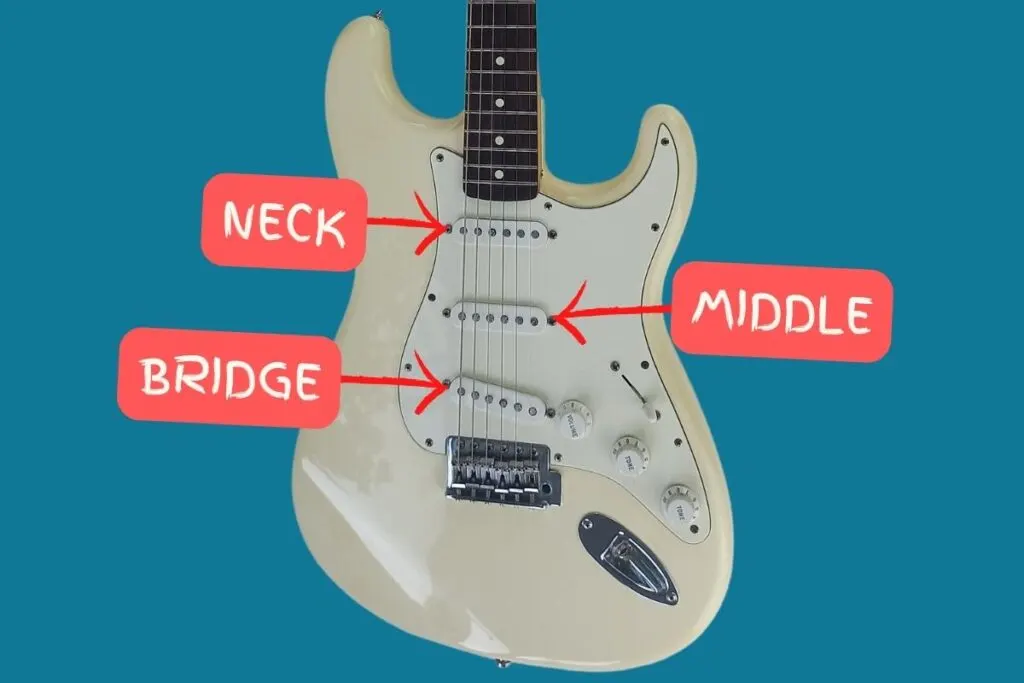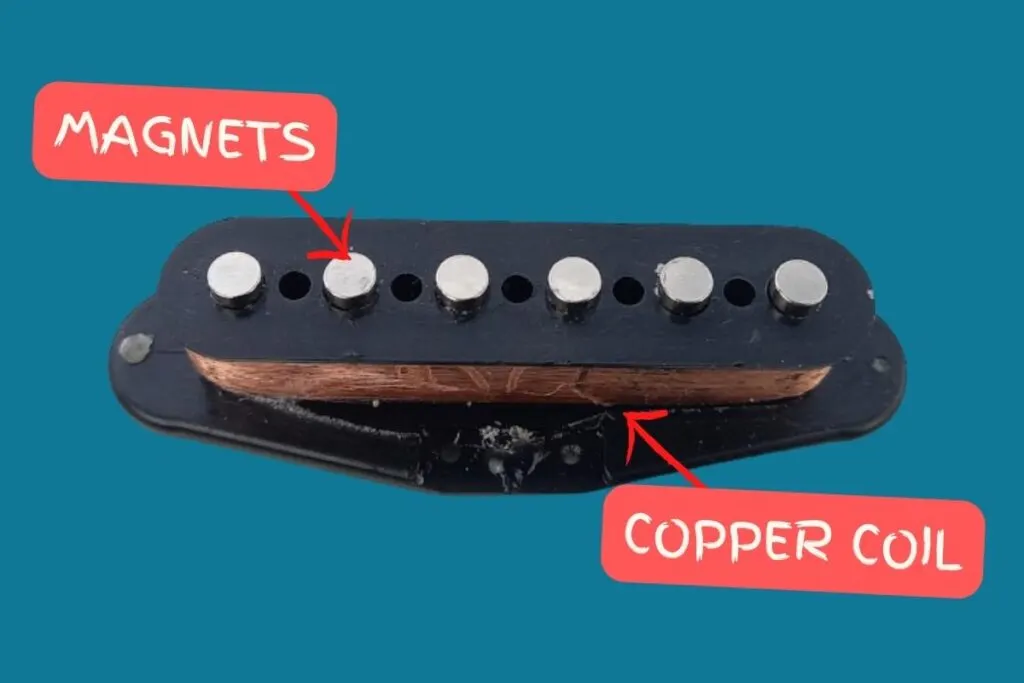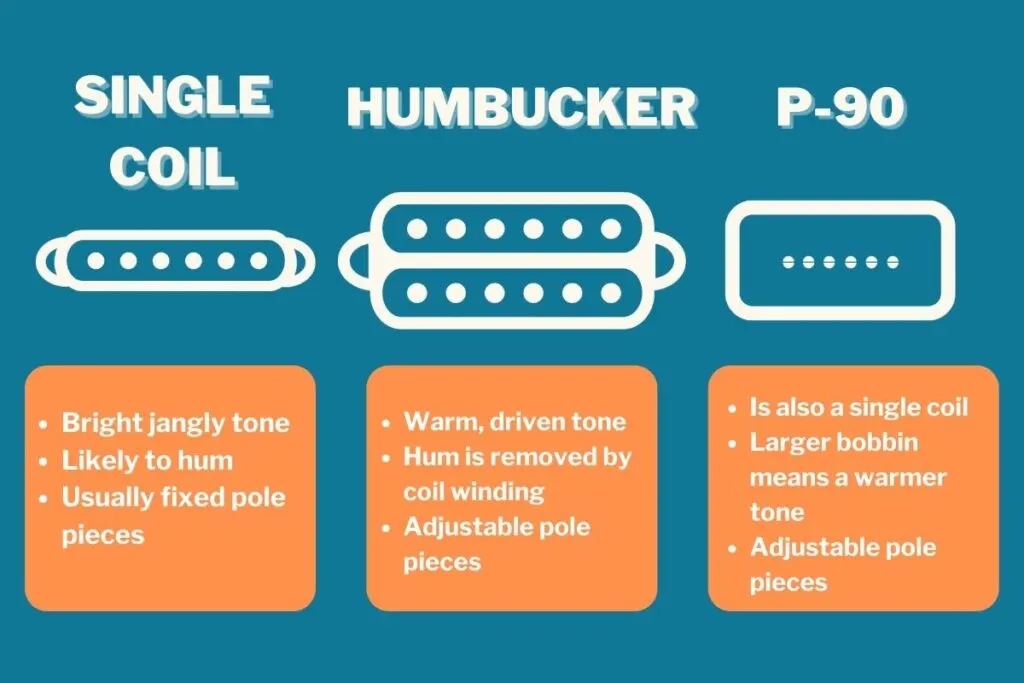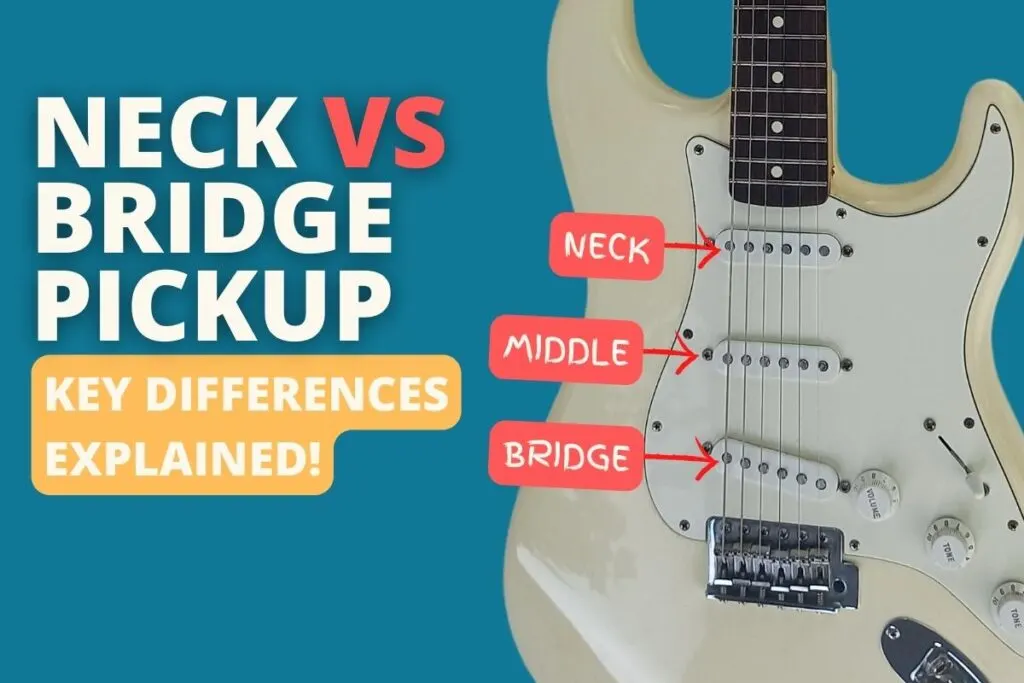Most guitars have a neck and bridge pickup, but have you ever wondered what the difference is between them? Most people will be able to hear that something sounds different, but what is it?
I’ve put this guide together to fully explain the differences between the neck vs bridge pickup to help you get the best sound out of your guitar.
What’s the difference between the neck and bridge pickup?
The main difference between the neck and bridge pickups is how they sound. A fun way to think of them is to picture the bridge pickup as the Sun, and the neck pickup as the Moon. The Sun is bright, vibrant, and powerful, whereas the Moon is mellow and soft. This is true for the pickups: the bridge pickup has a bright, treble-heavy tone, whereas the neck pickup is much smoother, with more bass and mid-tones.

Take a listen to the difference between the neck and bridge pickup on my Fender Stratocaster.
Here’s the crisp and bright bridge pickup:
And here’s the mellow, bassier neck pickup:
The differences in sound are due to how the pickups are made, their positions, and their output. All these factors are closely related to each other. Let’s take a look at these factors, and how they relate to each other.
1. Both pickups are in different locations
As the names suggest, the neck pickup is located closest to the neck and the bridge pickup is closest towards the guitar’s bridge. It might sound like an obvious difference – but it’s actually critical in explaining why these two pickups are so different.
It’s all to do with how the guitar strings vibrate.
First, a quick look at how pickups work (I’ve written a full guide here, if you want to know more). Your guitar pickups work by magnetizing the guitar strings above them, which creates a signal as they vibrate and move towards and away from the pickup (specifically, the copper coil inside the pickup). The more the string moves, the bigger and louder the signal is. That’s why the harder you pick a string, the louder it is.
But, your guitar strings vibrate differently in different places. They vibrate more towards the middle of the string, and less at the ends of the string.
So, what does this have to do with the pickup positions? Well, there’s more string movement above the neck pickup, and less above the bridge pickup. This is why the pickups are designed differently. If the pickups were designed the same, then the neck pickup would create a bigger signal than the bridge pickup, and be noticeably louder.
So they’re designed differently because of their positions in relation to the vibrating strings.
2. Both pickups are designed differently
I’ve mentioned that these two pickups are designed differently, but how so? They usually have the same shape and look similar – so what’s the difference? The main difference between a neck vs bridge pickup design is the length of wire that forms the copper coil. This coil is formed by wrapping a really thin wire around a bobbin several thousand times.

Again, it’ll be helpful to check out my article on how pickups work to get the full picture, but the copper coil generates a signal from the guitar strings.
But, it’s not only the movement of the string that’s responsible for the overall output level of the signal. The more copper wire used, the stronger the signal will be. Likewise, the less wire is used, the weaker the signal is.
Neck pickups use less wire to form the copper coil than a bridge pickup. This is because there’s more string movement over the neck pickup. If both pickups used the same amount of wire for the coil, then the neck pickup would be too loud. So, different amounts of wire are used to balance output the levels of the neck and bridge pickups.
3. Both pickups sound different
Now that you know more about how the pickups work, I can explain the biggest difference between the neck and bridge pickups: the sound.
Not only does the amount of wire used for the copper coil affect the volume, it also affects the tone of the pickup. Tone is the essence of a sound. A good way to demonstrate tone is to tap a table with your nails and then tap it with your finger. Both make a sound, but they have a different tone. Your nails will sound brighter, and your finger will sound more mellow.
A copper coil with less wire will have a darker tone, with more bass and mid frequencies. A coil with more wire has a brighter tone, with more treble frequencies.
In this case, the neck pickup has a mellower, warmer tone, and the bridge pickup has a brighter tone.
This quality is the same on all guitars. While the pickups themselves may sound different from guitar to guitar: the bridge pickup is always brighter and the neck pickup is always warmer.
What about the middle pickup?
Some guitars, like the Fender Stratocaster, also have a “middle” pickup that sits between the neck and bridge pickups.
This pickup can be seen as a blend between the neck and bridge pickup. It has some of the twang of a bridge pickup, with a little bit of neck pickup warmth.
Here’s a sound clip of the middle pickup on my Stratocaster:
As it’s a “bit of both” pickup, it tends to get ignored in favor of the other pickups – which both have a more distinct sound. The middle pickup used the most alongside either pickup, in positions “two” and “four” of the five-way pickup selector. In these positions, it’s activated alongside the neck or bridge pickup, and provides either a bit of twang, or a bit of warmth, respectively.
What else affects the sound a pickup?
It’s not just the pickup position and wiring that can affect its sound. There’s a couple of other factors that affect how a pickup sounds. Let’s take a look at them.
Pickup height
Pickup height has a huge effect on how loud or quiet the output from a pickup is. The closer a pickup is to the strings, the louder it’ll be. The further away it is from the strings, the quieter it’ll be.
This is really useful information to know when it comes to balancing the volume of your neck and bridge pickups. While the two pickups are designed to have a similar output level, you might find one to loud or too quiet compared to the other.
Each pickup comes with a pair of screws on the side that let you adjust the height of the pickup. Simply rotate the screws to increase or decrease the height of the pickup until you get the volume you want! I’ve written about this further in my troubleshooting guitar pickups guide.
Top tip: If you’re adjusting your pickups, start with the bridge pickup. Get this to the volume you want, and then adjust the middle pickup, followed by the neck pickup.
Magnets
The type of magnet used in a pickup can drastically change the sound of the pickup. This is all down to the strength of the magnet, measured in “Gauss” units.
Stronger magnets, like Neodymium, will have a brighter, louder, and crisper sound. A weaker magnet, like an Alnico II magnet, will have a warmer sound due to the weaker signal created by the coil. Typically, guitars with stronger magnets will have less sustain, as the magnets actually pull on the string. In some cases, it can even affect the tuning of the strings. (You can fix this by lowering the pickup!)
Likewise, dirt and grime can build up and affect the strength of the magnet. If it’s particularly bad, you might want to give your pickups a good clean!
In my experience, most neck and bridge pickups use the same types of magnets. But, you can swap out pickups with different types. If you find that you want more “bite” from your bridge, try a pickup with a stronger magnet. Want a more mellow sound? Try a weaker magnet.
In some cases, you can even swap the magnet without having to buy a new pickup!
Pickup shape
You’ve probably seen that pickups don’t just come in one shape. In fact, there are a lot of different shapes and sizes for pickups.
The most obvious comparison is single coil vs humbucker pickups. These aren’t just a different shape, but they’re wired to function in a different way from each other. Single coils often sound brighter but have more “humming”, and humbuckers sound warmer with less hum.

But even pickups of the same type will sound different if they’re a different shape. If we took two identical pickups and squashed one down to be flatter, we’d get a different sound from it. This is because the copper coil now has a different shape, which affects how it picks up the signal from the strings. This is exactly why a Jazzmaster and a Stratocaster style pickup sound so different, for example. Same design, different shaped coil.
When to use each pickup
I’ve seen quite a few people wonder when to use either pickup. Honestly, there’s no hard-and-fast rule. You should use each pickup depending on the sound you need. By taking some time to listen to how each pickup sounds, you’ll train your ear to learn which pickup you need to use.
Having said that, there are some general guidelines that you can follow to get you started!
When to use the neck pickup
The neck pickup has a soft, warm sound. This makes it great for rhythm guitar parts. It’s actually labelled as the “rhythm” pickup on the Les Paul for this reason. Its warmth also lends itself to softer styles of playing like jazz, blues, and funk. Check out “Le Freak” by CHIC. Guitarist Nile Rodgers uses only the neck pickup to deliver that iconic rhythmic riff.
The “darker” tone of the pickup also makes it a great choice for hard rock and metal playing, too. Adding some distortion or fuzz can really turn this pickup into a gritty, muddy monster.
But, this pickup isn’t just for rhythm. Countless guitarists use the neck pickup for thick, creamy lead solos. Slash, Jimi Hendrix, and Stevie Ray Vaughan are probably the best examples for this. Have a listen to “Couldn’t Stand The Weather” by Stevie Ray Vaughan. You can clearly hear that the solo uses a neck pickup (from about 2:45).
When to use the bridge pickup
The bridge pickup is sometimes called the “lead pickup”, and for good reason. This pickup has more high-end frequencies that make it great at cutting through a mix. If you need your guitar to stand out in a band, then the bridge pickup is the way to go.
This makes it great for crystal clear solos that will rise above the sound of a band.
But again, this pickup isn’t only limited to playing lead. In fact, I find myself using the bridge pickup for rhythm more than the neck pickup. The crisp bite makes it great for bright rhythm guitar parts like you might find in rock, pop, blues… to be honest, any genre!
The real trick is to sit down with your guitar and learn how the different pickups sound, and then you’ll be able to get the sound you need every time.
Conclusion
The neck pickup and bridge pickup on a guitar are both very different from each other. They need to be different because the strings vibrate differently above them. Consequently, the neck pickup has a lower output, and the bridge has a higher output. But, both should sound a similar volume when played through an amplifier.
Over time, the neck pickup has become known for its warm, mellow tone. And, the bridge known for its bright, cutting sound. While some guitars, like the Les Paul, label these pickups as “rhythm” and “lead”, it doesn’t mean that they have to be used that way.
Ultimately, playing guitar is about creativity and experimentation. The best way to learn the differences between them, and to find out when to use which pickup, is to sit down with your guitar and listen to the difference between these two pickups. Once you’ve learned this, you’ll open up endless possibilities to your guitar’s sound!
Related questions


Conor is a music producer, multi-instrumentalist, and all-round enthusiast from the UK with over 15 years of experience. He’s the founder and sole-content creator for the roundtable audio blog and YouTube channel.
